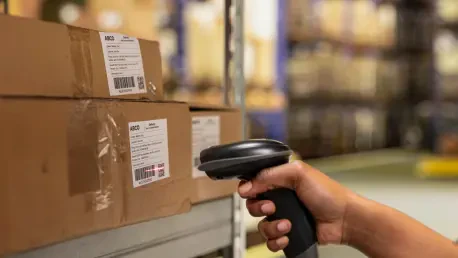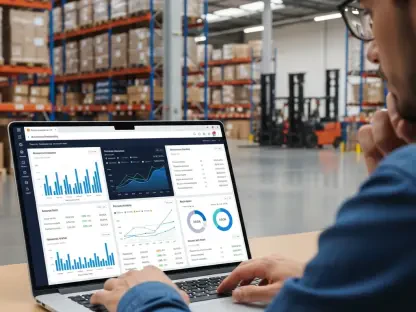In a world where nearly 30% of food produced globally goes to waste, costing the economy over $1 trillion annually, one retail giant is stepping up with a bold solution to tackle this crisis. Picture a bustling Walmart store where every piece of fresh meat or loaf of bread is tracked with pinpoint accuracy, ensuring nothing spoils on the shelf. This isn’t a distant dream but a reality unfolding right now, as Walmart harnesses the power of RFID technology to transform inventory management. This innovation promises not just fresher products for shoppers but a significant dent in the global food waste crisis, setting a new benchmark for retail efficiency.
Unlocking the Future of Retail with a Single Scan
The significance of this technological leap cannot be overstated. Walmart, as one of the largest retailers on the planet, handles an inventory volume that most businesses can only imagine, with fresh food categories posing unique challenges due to their short shelf life. By integrating RFID—or radio-frequency identification—into its operations, the company is addressing inefficiencies that have long plagued the industry. This isn’t merely about keeping shelves stocked; it’s about redefining how retailers can balance profitability with sustainability, ensuring customers get the best while minimizing environmental impact.
The implications stretch far beyond a single store or chain. With food waste contributing to 8% of global greenhouse gas emissions, according to the United Nations, Walmart’s move to digitally track perishable items could inspire a ripple effect across the sector. The ability to monitor expiration dates in real time and adjust stock accordingly offers a practical solution to a problem that affects millions of households and ecosystems alike. This story is about more than just technology—it’s about a shift toward smarter, more responsible retail practices.
Why RFID Matters in Today’s Retail Landscape
Retailers today face a complex web of demands, from ensuring product freshness to meeting consumer expectations for transparency. The pressure is especially intense in managing fresh food, where even a small delay in rotation can lead to spoilage and loss. Traditional inventory methods often rely on manual counts, which are time-consuming and prone to error, leaving gaps in efficiency that cost both money and customer trust. RFID technology steps in as a game-changer, offering a digital lens into stock levels that was previously unimaginable.
Beyond operational hurdles, there’s a moral and environmental imperative at play. The Food and Agriculture Organization estimates that reducing food waste could feed over 800 million people annually—roughly the population of the United States and Brazil combined. Walmart’s focus on RFID reflects an alignment with these broader goals, prioritizing traceability to ensure items don’t linger past their prime. This approach not only addresses immediate business needs but also responds to a growing public call for sustainable practices in everyday shopping.
Breaking Down Walmart’s RFID Innovation
At the heart of this transformation is a pioneering partnership with Avery Dennison, a leader in digital identification systems, announced on November 3 of this year. This collaboration has birthed a first-of-its-kind RFID solution tailored for fresh food departments like meat, bakery, and deli. Each product now carries a unique digital tag, allowing associates to track inventory with unprecedented precision, knowing exactly what’s on hand and when it expires. This level of detail is a stark contrast to older, less reliable methods.
What sets this technology apart is its ability to function in challenging environments. Historically, RFID struggled in high-moisture, cold settings such as refrigerated cases, where signals faltered. The new system overcomes these barriers, ensuring consistent performance even in the toughest conditions. Additionally, by digitally monitoring use-by dates, Walmart can rotate stock or offer markdowns before items spoil, directly slashing food waste. The efficiency gains are equally impressive, as automating inventory tasks frees up staff to focus on enhancing the shopping experience.
Voices from the Frontline and Industry Insights
Feedback from within Walmart paints a vivid picture of the impact. Christyn Keef, VP of Front End Transformation for Walmart U.S., highlighted the dual benefit of this rollout: “The goal is to simplify operations for associates while improving the customer experience.” Store teams have already noted a shift, spending less time on tedious paperwork and more on assisting shoppers, which boosts morale and service quality. This practical change underscores how technology can humanize retail work rather than replace it.
Industry watchers see this as part of a larger trend. Reports indicate that RFID adoption is surging across the food retail sector, with traceability becoming a top priority as consumers demand to know more about their purchases. Competitors like Kroger and Chipotle have also tapped into similar solutions from Avery Dennison, yet Walmart’s scale and ambition position it as a frontrunner. This collective push suggests that digital tools are no longer optional but essential for staying competitive in a rapidly evolving market.
Practical Takeaways for Retailers and Beyond
For other retailers looking to emulate this success, Walmart’s strategy offers clear lessons. Starting small by testing RFID in high-stakes categories like fresh food allows businesses to refine systems before scaling up, ensuring reliability in tough conditions. Using real-time data to track stock and expiration dates eliminates guesswork, paving the way for smarter inventory decisions that benefit both the bottom line and customer satisfaction.
Sustainability should also be a core focus. By leveraging technology to cut food loss, companies can align with environmental goals that resonate deeply with today’s eco-conscious shoppers. Equally important is empowering employees—automating repetitive tasks shifts their role toward customer engagement, enhancing service quality. These actionable steps, rooted in Walmart’s approach, provide a roadmap for blending innovation with purpose, proving that efficiency and responsibility can go hand in hand.
Looking back, Walmart’s journey with RFID technology marked a turning point in retail history. The collaboration with Avery Dennison redefined how fresh food inventory was managed, setting a precedent for reducing waste while prioritizing customer needs. As the industry continues to evolve, the next steps involve scaling these solutions across more categories and regions, ensuring broader access to fresher products. Retailers of all sizes are encouraged to explore similar technologies, adapting them to their unique challenges. The future of retail hinges on such bold innovations, and staying ahead means embracing digital tools to create a more sustainable, efficient shopping landscape.









